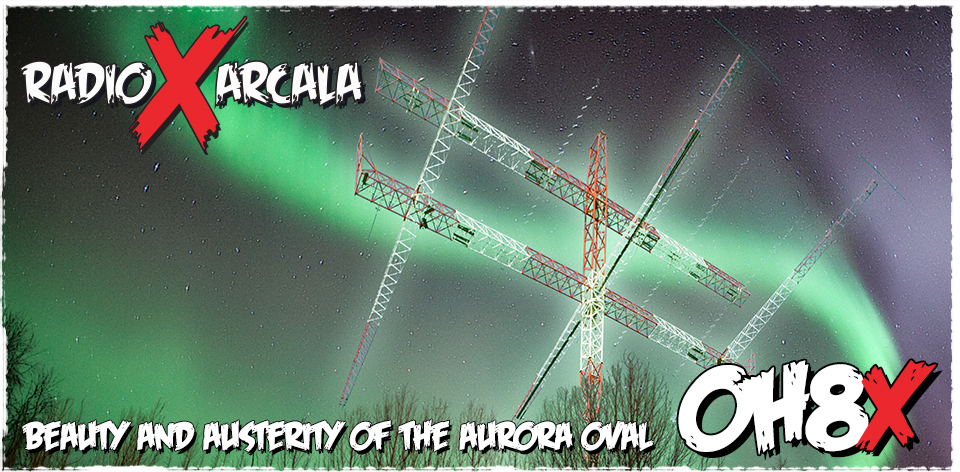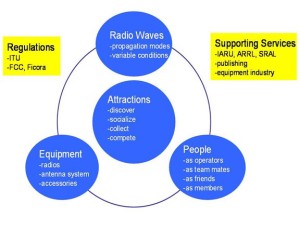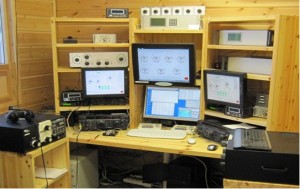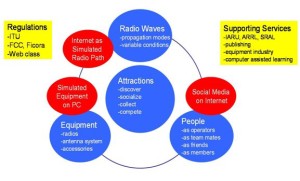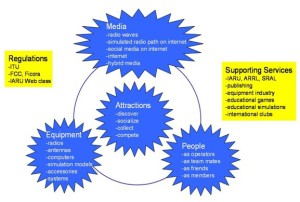Link to FUTURE OF AMATEUR RADIO discussion,
Preface
Amateur Radio (AR) as a beneficial passion with a valuable role in society has reached an alarming crossroads. According to a recent study and based on the demographics of a membership survey, it was concluded that the global AR population will diminish in the course of the next twenty years to the point where its existence is in jeopardy in terms of reaching a critical mass needed to conduct meaningful activities on the level assumed by this global pursuit. Also, it is unlikely that the needed equipment and the material necessary to provide a basis for AR activity will be available. The current influx of new members is not expected to secure the continuation of this valuable activity. The initial drivers – radio waves, radio communication over long distances at no cost and related theories and electronics as such – do not sufficiently attract today’s youth. A new strategy is needed for renewal.
Here is laid down some elements and seeks new attractions that can potentially bring a new lease on life to Amateur Radio together with young people, while honoring the past and providing the current aging population with ways to lead and be part of a proposed transition. At the same time, it is designed to help the elder generation gain further knowledge of new technologies and continue their enjoyment by coexisting in harmony with the youth of today.
Older age groups will be gone over the next twenty years, reducing the population to the point where Amateur Radio will be just fond memories of those other days. Can today’s amateur radio community realize their responsibility and set forth a new strategy?
Abstract
Amateur Radio combines technical experimentation, social networking and discovery of science and nature in a fascinating way which leads to a continuous process of learning and even a whole lifestyle for the presently declining AR population of some 3 million. In order to maintain its attractive appeal in a rapidly changing world, it is proposed that the framework of Amateur Radio be extended.
It is now suggested that the internet and the social media be brought into the core of Amateur Radio, in harmony with its existing range, by combining well proven social media driven internet communication methods and attractions with an Amateur Radio framework as an entry-level gateway to AR, practically removing traditional license exams and allowing potential youth to discover the magic of Amateur Radio inside our world and together with its existing population.
Here is described the new concept of Augmented Reality Amateur Radio (AAR) which partially utilizes the World Wide Web as its medium, and outlined the reasons why it is needed, and specified the necessary next steps forward.
A simulated amateur radio-like approach on the internet provides an easy-to-enter communication medium – a set of new “bands” and a natural learning experience for today’s youth while traditional amateur operators access internet-based amateur radio for a healthy cross-communication experience and technology upgrade.
Why We Exist
Amateur Radio as a hobby is as old as radio itself. Radio communication and technology were exciting new dimensions in the early days of radio with plenty of room for experimentation. Young people were especially enthusiastic about the new science. The hobby supported educational prospects in physics but it also offered a fertile seed for international social interaction. Common interest and a worldwide contact network made up an interesting new combination.
The spirit of radio amateurs constituting the first ever global community creates strong bonds between the practitioners of this hobby, with many of them seeking opportunities to help modernize the original passion while preserving the old and acting as highly valued Elmers eager to imbue today’s youth with the genuine spirit of Amateur Radio.
In those early days AR represented the main non-commercial global communication network – it was the internet of that era not only in terms of connecting private individuals together but also in helping society with many of its radio communication needs.
Over the span of many decades, Amateur Radio grew and gained permanent status as an International Telecommunication Union (ITU) recognized service with related radio frequency allocations. Those exercising the service needed to possess deep overall knowledge and be licensed upfront so as to comply with the standards of a relatively broad knowledge base as specified by the ITU.
Attraction Elements Needed to Win a Young Soul
Amateur Radio offers an exciting technical platform where learning and creativity through experimentation are possible. Discovering something totally new is limited but the possibility of using radio waves together and combined with other communications media still exists.
The elements of attraction of today’s Amateur Radio form four groups.
- Discover Learning other cultures, geography and even other languages and new science plus related theories through the radio spectrum at a young age is an important part of early discovery which will have a positive impact on young people at a time when they are considering their future study subjects, social responsibilities and career paths.
- Socialize Common interest in extreme radio communication brings people together to share the mystique and warrants further experimentation. Gatherings with like-minded friends on the radio or in person enrich friendships with many new flavors in people’s lives. People feel a strong sense of belonging to the amateur community. Involving AR in efforts to assist society in need has a long and rich history.
- Collect Many of us are keen on collecting something rare, “having them all”, and being recognized by our peers. Amateur Radio offers countless global opportunities for such an urge to accumulate a maximum number of objects on radio – be they countries, cities, islands or people with the same interests in life. Reaching such a goal will bring a sense of accomplishment with a good feeling and a major learning experience along the way.
- Compete Amateur Radio incorporates many “extreme elements” where the competitive urge can be satisfied by enabling one to become the best in a variety of elements that the entire AR concept is based on. Competitive skills are employed, with the radio spectrum serving as a playing field in several technologies and areas of expert knowledge at the same time. One can become the best and the most admired among the AR population by being a good radio operator or a popular technical expert among one’s peers.
Current license holders were attracted to Amateur Radio by the extremes and excitement of those other days. Today’s youth are attracted by extreme elements beyond the scope of free and reliable global person-to-person communication in their urge to be part of the social groupings of their like-minded peers.
Need for Renewal
Entry Barriers
Radio waves and radio propagation on various frequency bands as a function of solar activity provided room for fascinating experimentation in the course of the long history of Amateur Radio. They are still very much part of our everyday life, with wireless telecommunication injected everywhere. Required upfront license exam studies, without appreciating the necessity of such studies, constitute a barrier – a jump into the unknown – to young people who are exposed to many attractive internet offerings that allow for an immediate beginning.
Social Interaction
As the internet has taken over a major part of the role of social interaction between like-minded individuals, it is assumed that talking globally by radio does not provide an incentive for young people to enter into yet another social network as such. But a new well-thought-out internet attraction can bring masses of people together globally in record time. That common interest has to be defined and presented with the right message to carefully selected current and potentially new social communities. The current aging AR setting no longer provides a framework for that.
Gateway to a Professional Career and Good Citizenship
Practical and theoretical knowledge in Amateur Radio has provided a basis for many professional success stories in the past. Many thriving enterprises, many business and educational careers as well as cases of lives saved through Emergency Communications (EmComm) have originated from the traditional ranks of AR. An EmComm service in the hands of skillful radio operators is viewed positively in many societies particularly in the wake of numerous recent cases. These ultimate success stories need to be part of a new AR introduction, spelled out smartly using role models to make the case.
These elements can contribute to enriching the accumulation of knowledge and know-how when parents and teachers interact with young people in an effort to lead the youth toward desired paths in their lives.
Nothing Beats Fun and Excitement in Life
In the early days, the fun element led the way in establishing communication with distant lands and unfamiliar people. This was a precursor of globalization. Now the fun comes from a shared experience with other people, in a multinational and multicultural environment.
The fun experienced by young people can vary from country to country but the desire for person-to-person communication is the same. Social groupings and age groups may be country- and language-flavored. Experiencing the variety of attractions associated with Amateur Radio is highly educational.
Redefining the fun – immediate attraction elements – is our challenge. Approaching these groups of young people with the right message now provides an opportunity for those left to worry about the future of this passion. Each and everyone can do their share but the approach needs to be well defined among ourselves but also together with young people.
We need to redefine current attractions and introduce new elements in a natural way to take Amateur Radio into the world we live in today. Approaching the youth in their regular hangouts is essential. This assumes accepting something totally new and giving away something from the past. It is all part of progress in evolving societies.
Amateur Radio in Augmented Reality
It is proposed that Amateur Radio be extended to exist on the World Wide Web so that interaction with young people happens in their regular hangouts and within their natural communities. Before joining the ranks of the traditional Amateur Radio community, this will enable them to derive sufficient excitement during an entry phase:
- No traditional entry barriers will exist and the introductory phase will be only lightly regulated.
- With a two-tier approach, the selected immediate attractions will bring young people to a new world of social belonging through games, competitions and immediate voice communication with a new well structured international community.
- In the interim phase, the use of radio waves and related theories will be introduced through simulations and exhibits, adding to the scope of a proper entry phase and encouraging progress toward a true permit.
- The established matrix will see traditional and new amateur radio operators communicating with one another, with both parties learning from each other.
Amateur Radio has many supportive activities on the World Wide Web, but here the core is extended to let the internet reach the core of Amateur Radio – or the other way around – Amateur Radio’s core is shared on the Net with the young people already there.
Adding to the Cornerstones of Amateur Radio
Attraction and Fun – Discover, Socialize, Collect, Compete
The Augmented Reality Amateur Radio (AAR) approach can combine current and new attractions to reinvigorate those elements that form part of the existing world of Amateur Radio. Being a rare destination (DXCC country) or an island (IOTA) or a national county (USA-CA), and having a special collector’s item verifying the conversation (QSL) can still allow young people to partially satisfy their competitive urge. By extending geographical Amateur Radio into Mixed Reality, it is possible to create virtual destinations and new collection objects. The collector’s items in electronic format and their modern content represent a major opportunity, along with organizing Emergency Communication drills or setting up social study rooms as part of one’s personal evolution toward good citizenship. The opportunities arising from this new concept for global attractions are endless, combined with simulations of those that exist in the world of Amateur Radio today.
Radio Waves
Radio waves are at the center of all aspects of Amateur Radio. Multiple propagation modes and their variability are important ingredients of excitement and learning. By adding simulated radio paths to the internet, one can duplicate all current amateur frequency bands with a similar propagation behavior. New and current amateur operators can be part of a meaningful activity, with no upfront investment needed in their own equipment. This new approach can even substitute current activity for those afflicted with increasing digital noise or antenna restrictions.
Sunspots, the lifeblood of traditional AR communication, and their 11-year cycle can be simulated in Virtual Reality while mixed contacts between real and simulated space will bring young and old people together in Mixed Reality.
Equipment
Traditionally, the station equipment includes radios, antenna systems and station accessories. In virtual space, our radio will consist of software on our PC. It can behave and look the same as a normal radio but will represent no upfront cost. A radio contact – QSO in traditional radio terminology – via the internet will be quite exciting, using a natural but virtual framework to conduct structured two-way communication. Even a geographical location, station antennas and accessories can be simulated.
Potential new amateurs can initially operate on virtual radio bands. With no need to pass a written exam, they can start with a simulated radio on their PCs. An official radio license will not be needed on virtual radio bands. All young people have PCs and access to the World Wide Web.
People
The fourth element in the primary sphere of Amateur Radio consists of people. Besides seeing other people as radio operators, there is so much more. We learn from other people with the same basic interests, we work together, we help each other, and we become friends and have fun together – with radio or without. There are thousands of virtual clubs formed around common interests. Small interest groups share their experiences and undertake joint projects. Facebook and Twitter are popular sites in support of social networking. Amateur Radio operators will be active users of those, in parallel with a new AAR social grouping.
Supporting functions, such as administration and publications, where needed, can be the same as those in traditional AR. The needs of Mixed Reality Amateur Radio are similar and shall be integrated as part of the existing services.
These extensions and adjustments to traditional Amateur Radio result in a new AR category not initially using radio waves – described here as “Simulated Amateur Radio on the Internet”. Such can be this new approach to AR embodied by the new term – Augmented Reality Amateur Radio.
Operation in virtual space does not need to be nationally organized while the initial approach should be on a national society’s agenda to test and verify the nationally selected elements which often pose cultural and linguistic challenges. The work to create a virtual amateur radio world will make an excellent “open source” project for the amateur community as a whole.
Transition Model and Internal Merger
Here the key issue is whether we hold the power and have the urge to test new methods and whether we are willing to accept the dramatically changing times. The underlying issue is whether we recognize the paradigm shift happening and allow the internet to get to the core of Amateur Radio, potentially bringing in the masses of young people who are active on the internet. We expect that there will be resistance from the existing population in the same way that was the case when Morse code testing and communication were made voluntary for entry level amateur radio operators some years ago. Assuming that those in power are willing to proceed and make changes, the following discussion may be beneficial.
The International Amateur Radio Union (IARU) with its Member Societies should constitute an integral part of this potential project – we should not exclude prospective new entities having the desire and the drive to effect the needed change and to act as reviewing and/or technical partners to create the required infrastructure and administrative models assumed by this approach. Since this approach will lead Amateur Radio into the world of the internet, it is very likely that new partnerships will emerge and, gladly, these partnerships will most likely include key persons who can see and appreciate the fundamental values that need to be considered at all times as Amateur Radio enters Augmented Reality.
Amateur Radio is composed of four cornerstones: 1) attraction, 2) radio waves, 3) equipment, and 4) people. These four cornerstones and their order of importance – the driver’s seat – have changed over time while Amateur Radio as a whole is still based on these cornerstones.
From studying and understanding the behavior of radio waves, the focus once shifted to equipment with huge advances in electronics, from analog to digital, creation of the personal computer with application software such as antenna simulations, and finally leading to the complexity of digital and wireless communication which ultimately entered the scene. With our current modern world, the people aspect has become a major area of interest for the human mind. One just does not strictly wish to see radio signals as reflections of a mysterious faceless world. Rather, one tends to regard them as expressions of a desire to seek other like-minded people and even to let a radio contact steer one’s life in the direction of a new kind of adventures. Here the social grouping breaks through in one’s life and there is a tendency to allow new media to shape the process of making friends with other people, even if the origin of those friendships remains on the radio waves.
Ultimately – already happening as we speak – those attractions will dominate our lives and we allow our spare time to include detours to many yet unknown experiences, be they adventures, study packages, virtual travel, games or just a search for new information or interaction with other people. This new era already dominates our minds, and many of these detours are frequently labeled with an “extreme” marking. Life in developed countries is seen as something of an extreme experience, as a future dream journey on the space shuttle.
Here we will discuss these cornerstones with the idea of extending the current four corners to the extreme – if we ourselves are ready to take such steps – in a sense to give away something from the past and take on board those elements that resonate well with today’s youth, elements that we can only partially correlate to the past. Finding these totally new elements is to a large extent left to linger on in this paper, calling for participation and submission of ideas from those born and raised in the internet era; they are in a key position to draft totally new elements for selection.
Old Timers are aware of the changing world and the fact that young people tend to get excited when the target is set at a new extreme and not a time-honored achievement of bygone years. It is thrilling to witness yet another success story of Amateur Radio when Old Timers share the world with youth while preserving the original values of Amateur Radio.
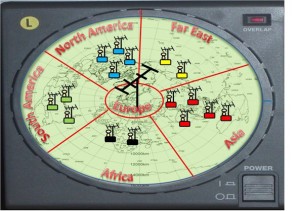
Figure 3: One can certainly listen or transmit in all directions at once – toward all country-based IP addresses – but if it is necessary to turn the beam, artificial or real, you may direct your call to those on the band – or in the global chat room – based on their geographic location. IP addresses are registered when checking into the DX Summit, which is rich DXCC-wise – with some 187 countries logging in every month.
Four Cornerstones at a Glance
Attraction
How can we attract the youth of today to our wonderful world of Amateur Radio? Modern-day young people grow up blessed with an abundance of competitive offerings and multiple PCs in their homes and pockets. What Amateur Radio has to offer should compete in getting the best of today’s youth to join in. Reasonable opportunities are not lost, but the AR community must live up to the challenge and devise a strategy accordingly.
The traditional sphere of Amateur Radio can be segmented into many interest areas using and experimenting on the radio waves. In approaching the youth, the appropriate scenarios must be well-thought-out while assuming the desire and urge of young people to experience science and the study of radio waves as an interesting medium of communication.
In choosing which group to approach, let us cite one example which may be useful. It is easy to understand that engineering students of all ages present more immediate opportunities for recruitment than those with a desire to study law. At the same time, an effort should be made to break the traditional barriers when it comes to a variety of interest areas – but as AR is not a profession, those interested may come from various walks of life.
Amateur Radio comes with ranking lists, such as DXCC, which may have to be retuned. Modern electronic QSL cards have the potential to carry more interesting data, plus sound and video clips, and they can be addressed to a much wider audience than is presently the case, in a much more timely and economical manner. The 1920’s approach needs to be modernized for a more informative, affordable and attractive effect. Even the authentication methodology can be easily improved over the current methods. Real-time competitions are possible as scores will be readily available at the end of the race.
Modern high-technology attractions can be part of the agenda for a group designing circuits or software for needed applications – within the immediate sphere of Amateur Radio or in conjunction with a larger open-source project.
Here, one of the key issues is to recognize whether the attractions ought to be country-specific to the point where they should be tested nationally. The initial offering may be language-specific, which would suggest country-specific test cases ultimately aiming toward the global community.
The attractions may be different between traditional and internet-based groups, but it is assumed that the common denominators will be same; discover, socialize, collect, compete. Here, the current population may have to be ready to accept adjustments and see the new attractions in a needed positive light.
This paper is not intended to present potential contemporary attractions for today’s youth. But it may help the project to zero in on the fact that we have to approach the youth in their existing hangouts – with the language and concepts that belong to their vocabulary. This is why some of the issues may have the capacity to resonate more with the Augmented Reality Amateur Radio approach.
Radio Waves, Now Called Media
Here the structure is such that an entry level exam is to be replaced by a modus operandi allowing a young person to join the internet bands with a basic understanding of how to behave with the existing population through a simple operating procedure and make friends. Belonging to an orderly amateur radio community shall be the aim.
Most of the learning about radio waves and basic theory is to be done with hands-on simulations. The behavior of the radio spectrum – the ultimate playing field – is set to be obtained seamlessly on the virtual bands through this two-tier approach.
With this in mind, our approach may well start with looking at the wireless world as it opens up to the youth of today. All the youth gadgets from wireless internet applications provide ample entry knowledge about the behavior of radio waves from upstairs to downstairs while the entire radio spectrum can be a study package available as part of an Augmented Reality tour. All simulated study packages shall extend to a variety of study tours offered by our new space in the area of basic science & nature relevant to our passion.
The extreme element and preparation for use of the actual radio spectrum can be experienced by undertaking a journey to a desired radio destination and/or partner. This can be made more challenging by creating more difficult and varied propagation patterns, by learning about sunspots and the reasons for day and night variations. This study tour can be both interesting and educational.
In the area of true radio propagation, one can learn by doing and not necessarily by studying textbooks about the complexity of radio waves. Here, the ultimate goal shall be not to have poor propagation at the time when necessary communication needs to be established. These two elements are not interlinked but will be learned in preparation for entering the ultimate level of Amateur Radio.
Equipment
Our existing radio stations feature a lineup of key units and accessories as they form an Amateur Radio setup and needed user interface.
Gladly, the personal computer is part of Amateur Radio at least in those countries where Augmented Reality Amateur Radio is to be initially released. The equipment, accessories, antennas and other items may be simulated as much as possible on the internet. It may well be that the operating tools have much the same look and functionality that will soon become part of everyday life when one enters the domain of traditional Amateur Radio.
Switching between several propagation and communication modes and spinning the radio dial may indeed be part of a potential key unit – the radio itself. Obtaining a different level of units may be linked to the gained experience and additional study modules. Even turning the virtual antenna in relation to propagation is possible, if that is what we desire.
Today’s rapid growth of remote operation of radio stations has already promoted a variety of virtual controls over actual functions, giving the user a right feel. Functionality and terminology are to be learned in preparation for gaining knowledge for needed operation in the real world.
Remote control of a real radio and AAR on the internet can coexist for those having no access locally to a true radio or who are victims of noise or restrictive antenna ordinances.
All radio worlds – local, remote and virtual – can practically employ the same radio front, such as the imaginary presentation shown in Figure 5.
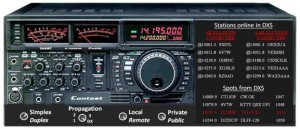
Figure 5: Using the radio’s front panel, whether a real radio or a PC screen, you can spin the dial on a virtual or real band but also command a remotely controlled radio. A propagation switch is set to desired band conditions where 1 simulates tough 160m conditions and the DX position opens 20m for solid 48-hour two-way contacts. A simplex / duplex switch is needed since many traditional operators may prefer talking in turns (simplex). A mode switch between public and private may serve the purpose as well.
Since the radio is connected to the internet, it can also act as a connection matrix for selecting those currently logged in to the DX Summit, whether on a real or virtual band. Ultimately, DX Summit spots may guide your operating pleasure on both bands.
In many cases, a proper equipment & functionality study tour can also help the traditional Amateur Radio community appreciate many of the controls ushered in by today’s technology. Do we all understand, for instance, the actual functionality of IPO, VRF, IDBT or the difference between NB1 and NB2, not to mention multi-layer radio menus, RS232 or USB connections available today?
Bringing traditional practitioners of our passion as well as new recruits together creates a basis for a healthy cross-learning experience. The introduction of many features associated with modern radio equipment and accessories and linking them to the internet can be of benefit even to today’s Amateur Radio population.
Take the case of antenna analyzers – understanding a plethora of values can be quite educational. Here, understanding the analyzer and the theoretical reasoning for any measured values both pose meaningful challenges for current and new members of the Amateur Radio community.
People
People of all ages and generations share one common factor – a desire to communicate easily and effectively. Inherent in the meaning of Destination X (DX) lies a fundamental mystique and a profound urge to know about distant lands and how to get there. There is no question that communicating with far-away and unfamiliar places has always provided more excitement than talking to one’s nextdoor neighbor. But upon entering the world of science, the priorities may change. Getting somewhere on an extreme wavelength is a pleasure cherished by many.
These desires and passions can also be experienced with simulated methods, up to a desirable point.
But the actual communication between people has also changed. As we often tend to seek out like-minded people, we need to know more of them. Our urge to socialize with similarly inclined people has increased manifold through effective communication on the internet. But this will not just take us to the existing areas of interest – the urge to learn and be part of new social groupings is quite evident.
The medium of socializing has changed. The traditional “open forum” of Amateur Radio may sometimes need to be switched to a “private room”. General discussion among friends may often be narrowed down to a detailed debate or a case study between just two individuals. Amateur Radio has always acted as a big propagation-driven “global and open chat room”, if you will. Amateur Radio has succeeded in enlisting a large population, in comparison with the PC-based world, causing congestion and pileups – all natural and well-known features in the world of traditional Amateur Radio. On a new band, one may choose between open forum and private room.
We suggest that Amateur Radio be considered as just another social group, accepting the challenge to open the eyes of young people to see the value of a well-structured and managed global chat room. A future vision may be one of everyone within Augmented Reality Amateur Radio wearing a T-shirt with an individual IP address at their first club meeting, whether or not everyone is physically present at the club gathering.
One may be concerned about the authenticity of a station and its callsign on the internet. Just as on the DX Summit, here every entering source of communication can be tracked or blocked by way of the IP address that we all carry with us today for our modern ID.
Conclusion
Amateur Radio’s future is on the agenda wherever several ham radio operators meet. There exists a high degree of consensus that a new strategy and some readjustment will be necessary. Actually, work on that new strategy is already overdue with a high sense of urgency. It is now up to the Amateur Radio community to determine how much of these traditions should be modified to gear this valuable hobby to the interest level of today’s youth.
Global communication, at no cost, has reached totally unexpected heights and our passion is not as competitive as it was before. Additionally, the renewal of our aging membership is needed to protect our valuable service and to give the whole service a new lease of life.
Gladly, members of the same generation who once experienced the past are here to witness the needed change and to share and be part of the new world with today’s youth. The new is on hand but just in its infancy with the first-generation internet users around us. Soon the World Wide Web is reaching entirely new heights – with sounds and live 3D characters, avatars and real-time virtual life, including shopping, traveling and mapping plus easy navigation and hundreds of new applications that will all challenge the traditions and the past.
It is now up to the Amateur Radio community to draft a new roadmap for joining the bandwagon for charting its own future and to continue being part of the evolving society the way we have been in the past. This paper is intended to open our eyes to set the course and to choose the direction to do so without wasting any more valuable time.
Acknowledgements
Looking to the future has always been more challenging than reviewing the past. That is exactly what the team at Radio Arcala is trying to do through this project. While sitting around the fireworks under the blazing skies of Lapland’s Aurora Borealis, the light suddenly came to them. The message came loud and clear – this valuable passion needs to be enhanced and taken to the youth on their terms.
We would like to thank the Center for Wireless Communications (CWC), the research unit of the University of Oulu, and their head, Professor Pentti Leppänen (OH8AXP), for facilitating this project and identifying Amateur Radio as a source of skilled engineers with the heart and soul to take wireless communication to heights not seen even today.
Radio Arcala would also like to thank Mr. David Sumner (K1ZZ), CEO of the American Radio Relay League, Inc. (ARRL), Mr. Riley Hollingsworth (K4ZDH), Special Counsel (Ret’d) of the Federal Communications Commission (FCC) Enforcement Bureau, and Mr. Hans Persson (SM6CFO/SU9HP), with longstanding experience of coexistence between the telecommunications industry (Ericsson) and Amateur Radio, for their encouragement, experience and vision while this paper was prepared.
*
Project Supervisor
Pentti Leppänen, OH8AXP
Project Task Force
Juha Hulkko, OH8NC (Chairman); Pekka Ketonen, OH1TV;
Martti Laine, OH2BH and Toni Linden, OH2UA
Project Technical Experts
Veijo Kontas, OH6KN and Tommi Hollström
Project Support
Jarmo J. Jaakola, OH2BN and Wayne Mills, N7NG
